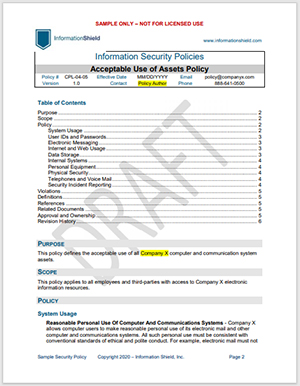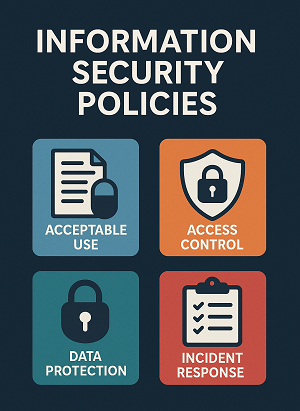Information Security Policies, sample policy templates, Security Policy Whitepapers
Top Information Security Policies to Protect Your Business in 2025
Introduction to Information Security Policies
In today’s digital world, data is one of the most valuable assets a business can have. But with that value comes responsibility—and risk. Information security policies are formal business rules that help organizations manage and protect data from unauthorized access, misuse, or theft.
These policies set clear rules for employees, third-party vendors, and stakeholders, helping reduce the risk of cyberattacks while ensuring compliance with laws and standards. Whether you’re a startup or a multinational corporation, a well-drafted information security policy is your first line of defense.

Objectives of Effective Security Policies
Information security policies serve several vital purposes:
- Safeguarding Sensitive Information: Policies outline how to handle and protect personal, financial, and business-critical data.
- Ensuring Legal and Regulatory Compliance: Many industries require written policies to comply with regulations like GDPR, HIPAA, and FTC Safeguards and CMMC.
- Minimizing Operational Risk: Clear security policies reduce the likelihood of human error and provide steps for recovery if an incident occurs.
- Setting Organizational Business Rules: They define acceptable behavior, enforce accountability, and set expectations.
- Communication with Constituents: Policies communicate business rules to employees, contractors, third-parties and regulators.
Core Elements of an Information Security Policy
A comprehensive information security policy typically includes:
| Element | Description |
|---|---|
| Purpose & Scope | Defines what the policy covers and why it exists |
| Roles & Responsibilities | Clarifies who is responsible for policy enforcement and adherence |
| Security Policy Statements | Specific security policy statements, organized by category |
| Policy Enforcement | A statement that describes consequences for non-compliance. |
| Definitions | Definitions of key cyber security terms used in the organization |
| Governance & Review | Listing of Policy Author and approving Senior Manager. Includes update history. |
Types of Information Security Policies

In general, an organization should have written security policies that cover all of the essential cyber control areas. These control areas are defined in common frameworks such as ISO 27002 and NIST CSF. Some examples include:
1. Acceptable Use Policy (AUP)
Determines how employees use company IT resources responsibly and securely. All employees should read and formally acknowledge the Acceptable Use Policy.
2. Access Control Policy
Dictates how users are granted and revoked access to systems and information. This includes two-factor authentication.
3. Data Protection Policy
Explains how personal and business data should be stored, transmitted, and disposed of.
4. Incident Response Policy
Outlines how to detect, report, and respond to cyber security incidents. The policy should specifically address response to phishing and email compromise, by far the most common source of data breaches for a business.
5. Remote Work & BYOD Policy
Covers secure remote access, personal device use, and mobile data protection. Employees now work remotely in large numbers, a Mobile Security Policy helps protect against data loss and improper access.
Of course, these are only some of the policies required for a complete information security program. To address major regulations like ISO 27002 or NIST CSF will require around 10-20 separate policy documents.
Information Security Policy Frameworks
Several globally recognized frameworks provide guidance for building effective policies:
- ISO/IEC 27001: The international gold standard for Information Security Management Systems (ISMS).
- NIST Cybersecurity Framework: Widely used in the U.S. to assess and improve cybersecurity practices.
- CIS Controls: Offers 18 control categories to protect systems and data.
- NIST 800-53: Provides specific requirements for security policy contents and structure.
Policies that reference these frameworks not only enhance credibility but also help in meeting compliance requirements.
How to Develop an Effective Security Policy
Creating a security policy doesn’t have to be daunting. Follow these steps:
- Define Objectives: Determine the goals of your policy—compliance, risk mitigation, etc.
- Engage Stakeholders: Include IT, HR, legal, and executive teams for holistic coverage.
- Identify Risks: Understand the types of threats your organization faces.
- Draft Clear Rules: Keep language simple, direct, and enforceable.
- Implement and Distribute: Make the policy available to all relevant parties.
- Review Periodically: Update based on technology changes or new regulations.
Using a set of pre-written security policy templates that follow this structure can save weeks of effort and produce better results.
Best Practices for Policy Implementation
- Mandatory Training: All employees should undergo policy training during onboarding and annually thereafter.
- Clear Enforcement: Define consequences for violations to ensure accountability.
- Version Control: Keep track of updates and distribute the latest version company-wide.
- Management Endorsement: Leadership support increases policy adoption and effectiveness.
Common Mistakes in Security Policy Management
Avoid these pitfalls to keep your policies strong and effective:
- Too Much Technical Jargon: Keep it user-friendly.
- Ignoring Employee Feedback: Involve staff in crafting practical, realistic policies.
- Infrequent Updates: A static policy becomes obsolete quickly.
- Lack of Enforcement: Policies without consequences are easily ignored.
Role of Leadership in Policy Enforcement
Top-level support is crucial for a successful security policy. Leaders should:
- Set the tone by following the rules themselves.
- Allocate budget for cybersecurity training and tools.
- Monitor compliance metrics and intervene when necessary.
Executive buy-in transforms a written policy from a generic document into a living security culture.
Employee Education and Training
A strong security policy is only effective if people follow it. Here’s how to ensure that:
- Monthly Refreshers: Keep awareness high with short, regular updates.
- Phishing Simulations: Test and train staff on spotting email scams.
- Gamification: Use quizzes and rewards to make learning fun and memorable.
Trained employees are your strongest defense against cyber threats.
Measuring Policy Effectiveness
Success isn’t just about having a policy—it’s about how well it works:
| Metric | Indicator |
|---|---|
| Incident Rate Reduction | Fewer breaches or events |
| Audit Results | Improved compliance during third-party reviews |
| Employee Compliance | Completion of training and policy acknowledgment |
| Policy Quizzes | Test user knowledge of security policy clarity and usefulness |
Tools and Templates for Policy Creation
Need a starting point? Existing Policy Templates can get you started and save money.
- Information Shield Security Policy Templates
- SANS Institute Security Policy Lihttps://www.sans.org/information-security-policy/brary
Some Governance Risk and Compliance (GRC) tools provides templates of information security policies. For example, the Common Policy Library is mapped to many different regulatory frameworks.
Industry-Specific Requirements and Regulations
Certain sectors have unique policy obligations:
- Healthcare: HIPAA mandates detailed data privacy policies.
- Finance: Must comply with SOX, GLBA, and FFIEC regulations.
- Education: FERPA requires policies protecting student records.
Check your industry’s standards and tailor policies accordingly.
Challenges in Maintaining Security Policies
Even the best policy faces hurdles:
- Rapid Technological Changes: Cloud, AI, and IoT require constant updates.
- Remote Workforce Growth: Policies must adapt to flexible work models.
- Internal Resistance: Employees may view rules as burdensome unless properly explained.
Clear communication and regular updates help overcome these obstacles.
Enforcement of Information Security Policies
Security policies are not effective unless they are enforced by the organization that creates them.
- Governance Risk and Compliance: GRC tools support “Administrative” controls and help build, manage and track security policy acceptance.
- Technical Policy Enforcement: Standard information security tools like malware scanning, firewalls, IDS, 2FA and vulnerability scanners all enforce technical policy controls. Many organizations have these tools but do not link them back to written security policies.
- Continuous Monitoring: Integration with SIEM tools for real-time enforcement alert management teams of events.
An effective information security program requires both written information security policies and the technical tools to enforce the policies
FAQs About Information Security Policies
1. What is an information security policy?
It’s a formal document outlining rules to protect data and IT resources. The information security policy is like a “contract” with employees and management on how information is protected.
2. Who is responsible for enforcing security policies?
Generally IT departments enforce policy compliance, but senior leadership must support and monitor enforcement.
3. How often should policies be updated?
At least annually or after significant technological or regulatory changes.
4. Can small businesses benefit from security policies?
Yes! Even a one-person business should define basic security practices.
5. Are policy templates a good starting point?
Absolutely. Just ensure they are customized to your organization’s needs.
6. What happens if we don’t follow our security policy?
Violations can lead to data breaches, legal penalties, and reputational damage.
Conclusion
A strong set of information security policies is more than a compliance requirement—it’s a cornerstone of a secure and resilient organization. From defining clear guidelines to implementing training and enforcement, your security policies can make or break your defense against cyber threats.
Don’t wait for a breach to take action. Review, update, and reinforce your policies regularly to keep your data safe and your operations running smoothly.
